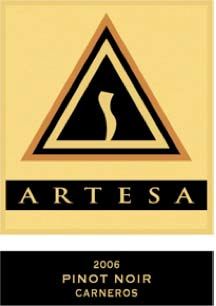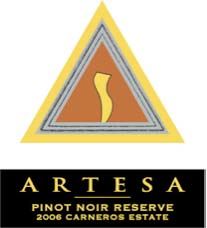Artesa Vineyards & Winery: Art, Architecture and Pinot Noir
I visited Artesa Winery in Napa Carneros in December of 2008 as a guest of Dave Dobson, the personable
Chief Winemaker. I was well aware of the winery’s sparkling wine history but did not realize the scope of the
current Pinot Noir still wine program. After tasting through the current lineup of Pinot Noir releases and talking
pinotspeak with Dave, I feel this winery is worthy of your attention.
Artesa (ahr TESS uh) translates as craftsman in Catalan, the language of Barcelona, Spain and of Codorníu,
the winery’s owner. The Codorníu family has been making wine since the mid-sixteenth century in the
Penedès region of Spain, west of Barcelona. In 1872, the winery produced the world’s first méthode
champenoise wines outside of Champagne, France. The new sparkling wine was called “cava” after the caves
or aging cellars.
In 1991, the owners of the Codorníu Group, the Raventós family, opened the Codorníu Napa sparkling wine
facility on a 350-acre estate overlooking the Carneros side of the Napa Valley. Sparkling wine demand lagged
in California thereafter and despite the $30 million initial investment, the decision was made to completely
transform the sparkling wine production winery into a still wine producing facility. In addition, vineyard
acquisitions were obtained in some of the best growing areas of Napa. The new winery and vineyard additions
amounted to another $20 million investment. The Artesa Winery officially opened in 1997 with the release of
the winery’s first still wines.
The winery is an architectural marvel, conceived to be in harmony with the landscape. Designed by local
architect, Earl R. Bouligny, the winery was built by removing and setting aside 30 feet of hilltop, matching the
winery’s height to the hill’s original elevation, then covering the 127,000 square foot facility with reserved earth
and planting the cover with native grasses. As shown in the photo below, the naturally insulated winery blends
perfectly with the surrounding hillsides. The panoramic view of distant vineyards in Napa Carneros from the
Artesa Winery terrace is shown in the second photo below.

The winery inside is ultra modern yet retains Artesa’s Spanish heritage, creating an environment that is
intended to heighten the visitor’s wine tasting experience. In keeping with Codorníu’s historical commitment to
art, resident artist Gordon Heuther’s tasteful works in various media such as glass and metal are exhibited
outdoors and throughout the winery. There is both indoor and outdoor seating for visitors to relax and explore the wines of Artesa Winery. Spend some time here and you will come away with an appreciation of Artesa’s
“wine as art” philosophy. The visitor’s center is open daily at 1345 Henry Road.

Artesa Winery produces multiple still varieties sourced from its 330 acres of vineyards in Carneros, Foss Valley
Vineyards in the Atlas Peak AVA of Napa and the Alexander Valley AVA of Sonoma. The 150 acres of Carneros
vineyards are devoted primarily to Chardonnay and Pinot Noir. The plantings are located on rolling hills with a
diversity of terrain, varying between 200 and 400 feet in altitude. The hillside location of the vineyards insures
that spring rains drain away by early summer, preventing undesirable vigorous vine growth. The soils are a
combination of alluvial sub-soils and shallow top-soils of weathered shale and sandstone. Each day as the sun
warms the vineyards, the rising hot air draws in cool air and fog from the nearby San Pablo Bay and Pacific
Ocean, guaranteeing a long and moderate growing season. Vineyard manager Don Clark is Artesa’s straighttalking
Texan who oversees the sustainable management practices used in all the estate vineyards. All estate
vines are cordon-trained on vertical trellising and there are 20 clones and selections of Chardonnay and Pinot
Noir.


Dave Dobson struck me as very confident and relaxed, despite the
responsibility of directing such a large operation (100,000 cases annually).
A holder of a Bachelor’s Degree in Chemical Engineering from Johns
Hopkins University and a graduate of University California Davis, Dave
came to Artesa in 2005 from Rutherford Hill Winery. Previously he spent
five years at Sonoma Creek Winery following which he became Head
Winemaker of Kendall Jackson premium wines. I like his philosophy of
winemaking. Dave says, “The most important aspects of winemaking are
vineyard sourcing, judicious use of oak and the people involved in the
process. Working in the vineyards is the part of the job I love most because
it’s where sun, rain and soil meld into something sublime. The winemaker
can have a huge impact on quality by ensuring even ripening and by
determining when to harvest. In the vineyard, improvements can be
dramatic and profound.” With Pinot Noir he looks for fruit-forward yet
elegant wines crafted with gentle winemaking practices. Dave is supported
by assistant winemakers Nori Nakamura and Ted Henry.
Artesa produces both a Classic Tier and Reserve Tier of Pinot Noir along with Limited Release Wines as
vintages dictate. Codorníu sparkling wines are also available and distinguished (10,000 cases). The wines are
available for sale in the winery’s visitor center, on the website at www.artesawinery.com and through retail
distribution channels. Four wine tasting experiences are offered at Artesa Winery including a private tasting
with the winery’s wine educator, an intimate wine and cheese tasting, a unique vineyard tour and tasting, and
an exclusive barrel room tasting of the winery’s best, very limited wines. Call the winery at 888-679-WINE for
availability and appointments. Artesa wines can also be sampled at Cornerstone Place in the town of Sonoma
(www.cornerstonegardens.com).
I tasted five Artesa Pinot Noirs at the winery. In addition, three wines (2007 Carneros, 2006 Limited Release,
and 2006 Haire) were re-tasted at home on a later date. The 2006 Carneros Pinot Noir was only tasted at
home. The Artesa Pinot Noirs all drank nicely following a progressively increase in intensity, structure and
tannins from the Classic Carneros Pinot Noir to the Limited Release Block 91 D Carneros Pinot Noir. Oak was
not an issue with any of the wines. Dave’s Artesa Pinots are easy to recommend.
2007 Artesa Carneros Pinot Noir
13.9% alc., 22,000 cases, $25. Aged 10 months in French
oak.
·
The is reminiscent of cherries kissed by good dark chocolate. Moderately light and
smooth in texture with fine-grained tannins and admirable acidity. A very good entry Pinot Noir
and daily drinker. Fantastic quality considering the extremely large case production.
2006 Block 91 D Carneros Pinot Noir
14.7% alc.,100-120 cases, price TBA.
·
A highly structured wine with
substantial tannins. Shy on the nose but powerful in the mouth with deep, rich darker fruits complimented by
smoky oak and an Oreo cookie taste. Still closed and brooding, this one will require at least 1 to 2 years in the
cellar but will always be a muscular wine.
2006 Artesa Carneros Pinot Noir
13.9% alc., $25.
·
A light and feminine Pinot Noir showing delicate cherry
and strawberry aromas and flavors enhanced with spice and savory herbs. A simple but pleasing wine with
commendable balance. Perfectly fine with grilled salmon.
2006 Artesa Estate Reserve Carneros Pinot Noir
14.35 alc., 3,500 cases, $40. Aged in 50%
new French oak.
·
A step up in aromatic intensity from the regular Carneros bottling. Aromas of
red berries and cherries touched by herbs. Friendly in the mouth with good red fruit intensity, an
appealing spiciness, and a silk and satin texture. The finish has noticeable persistence.
2006 Artesa Limited Release Carneros Pinot Noir
14.5% alc., 800 cases, $50. Aged 10 months in French
oak barrels. Composed of the most outstanding barrels in the cellar.
·
Darkest in color of all the wines tasted.
A pinotypical nose of dark berry and cherry fruit with a sidecar of oak. Tasty blackberry and black raspberry
fruit with an appealing earthiness and a hint of citrus peel tang on the persistent aromatic finish. A substantial
wine that is still reticent and needs time to shed some of its soft, dry tannins. A year or two in the bottle will
benefit this wine. That said, I drank this wine at the winery with pan roasted wild sea bass with Meyer lemon
buerre blanc, quinoa pilaf and Sicilian spinach and the result was spectacular. The roasted fish tamed the
tannins of the wine and the grippy acidity of the wine matched perfectly with the buerre blanc.

2006 Artesa Haire Vineyard Carneros Pinot Noir
14.7% alc., 100-120 cases, $80. This
wine is sourced from a unique site that formerly provided grapes for Etude’s Heirloom bottling. The
clones are Swan and Martini. Rapidly draining compressed ash soils characterize this vineyard in
contrast to the uplifted clays of varying depths over rock in the vineyards close to the winery.
·
Evocative scents of Bing cherry, herbs, cola, toasty oak and a faint whiff of alcohol. This wine has a
silky, comforting quality that is quite sexy. The tasty cassis and cherry core has subtle notes of
citrus, Provencal herbs and oak in the background. The tannins are well tamed and the overall
impression is one of assertive elegance reflective of winemaking excellence.
Note: After writing this article, I was informed that winemaker Dave Dobson had left Artesa but remains a consultant. Dave is in charge at Carneros Vintners, a custom crush facility where he will oversee winemaking and also develop his own label. Mark Beringer, formerly of Duckhorn, has taken over the reigns at Artesa.








